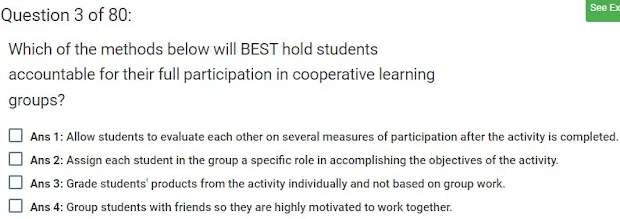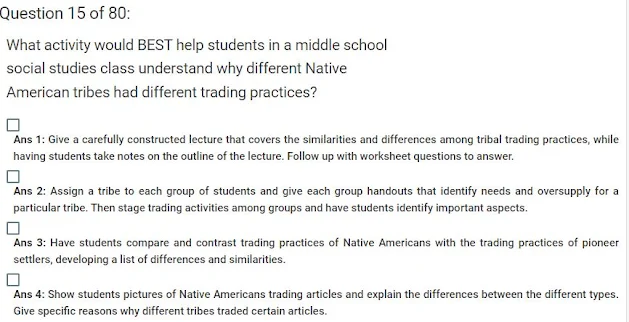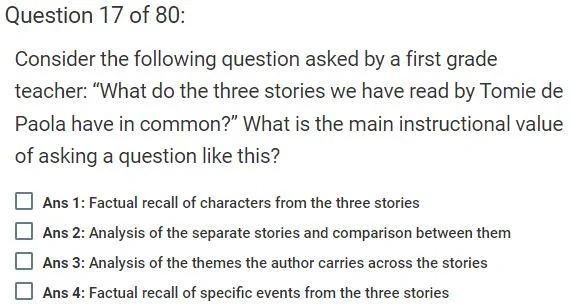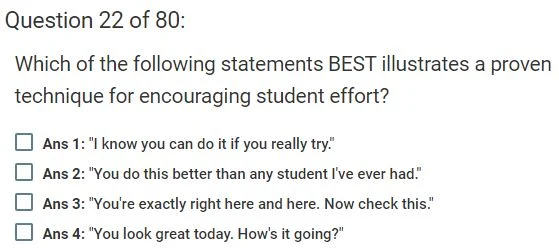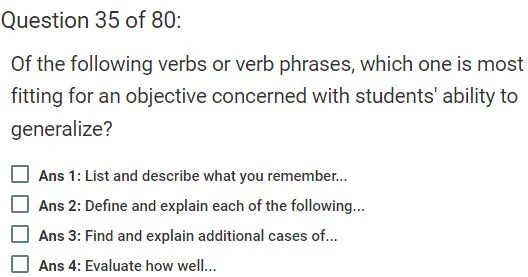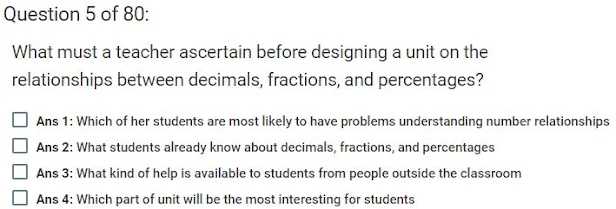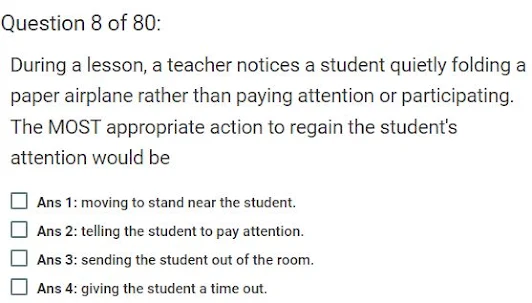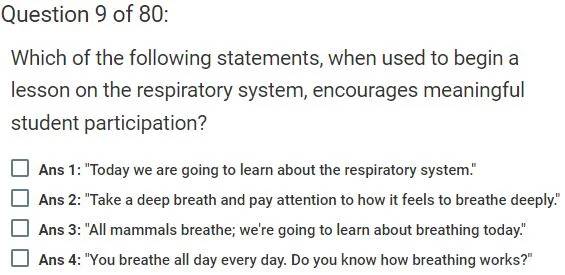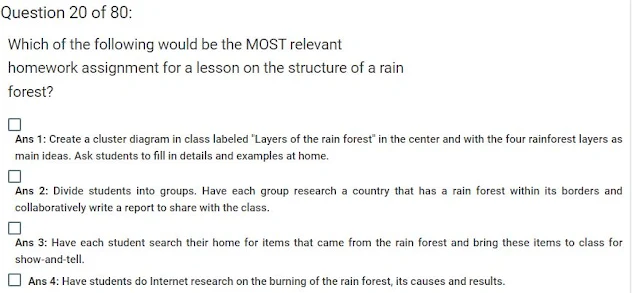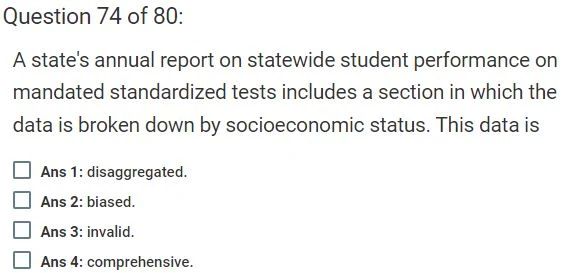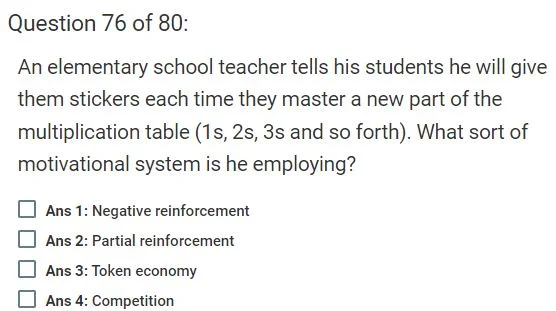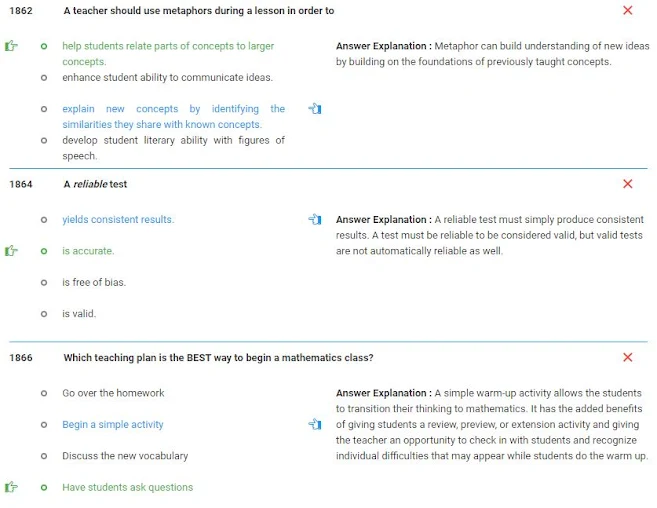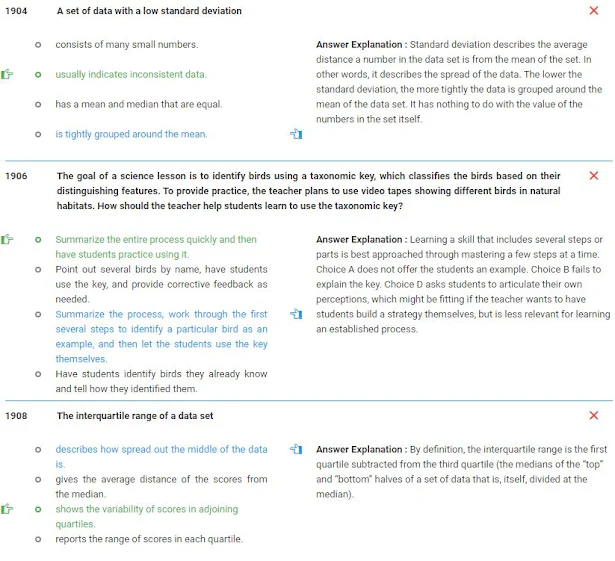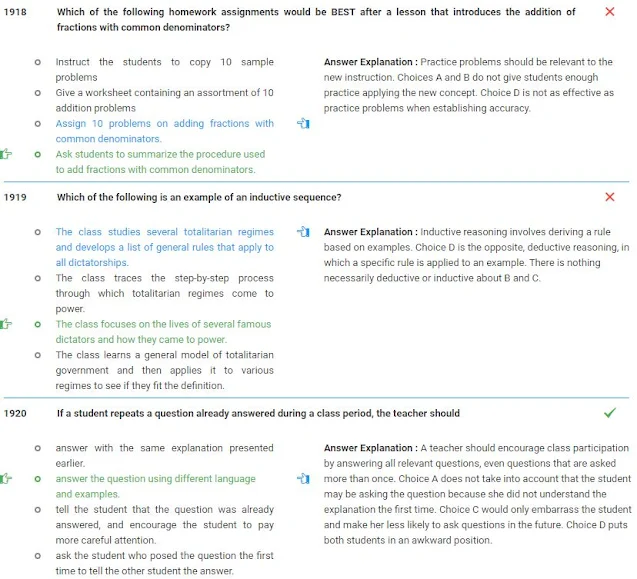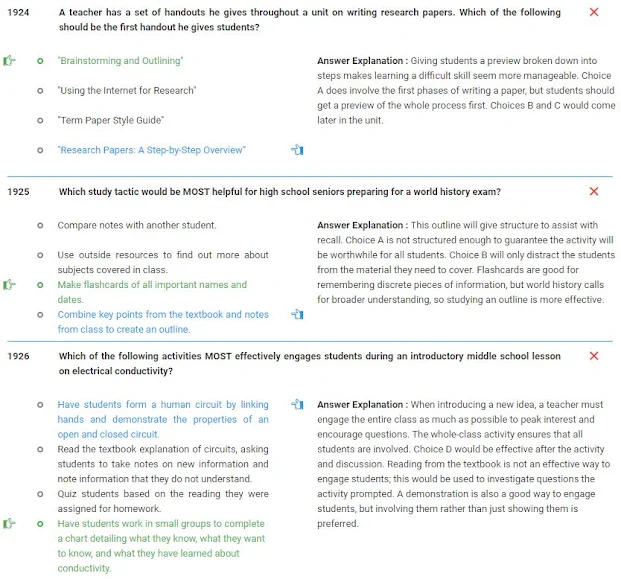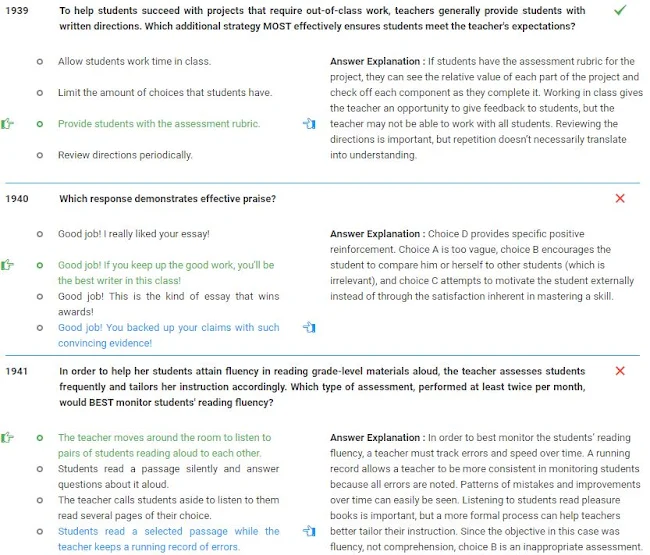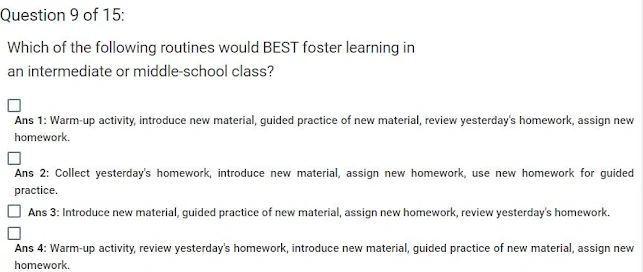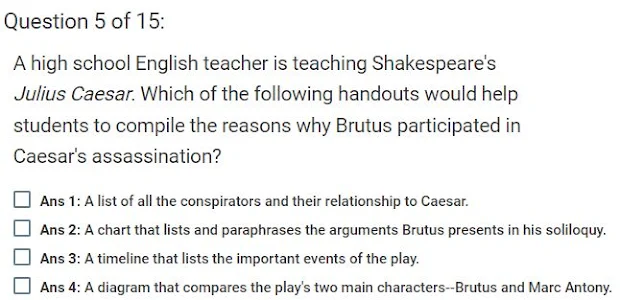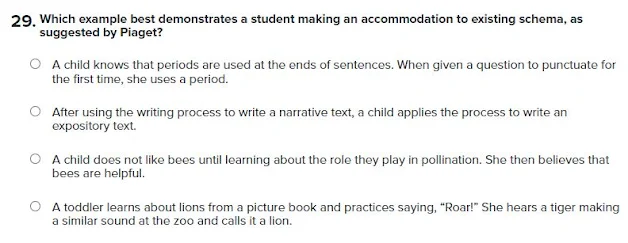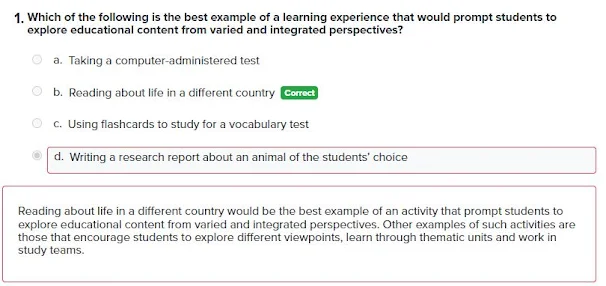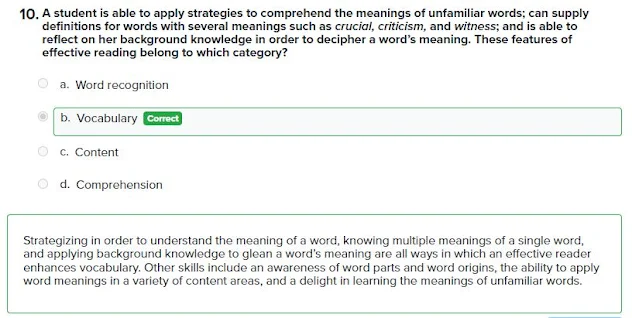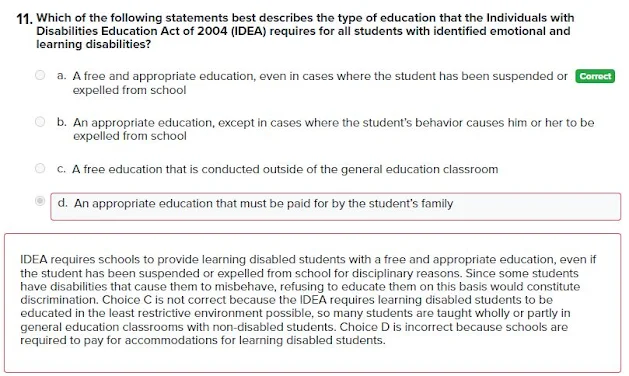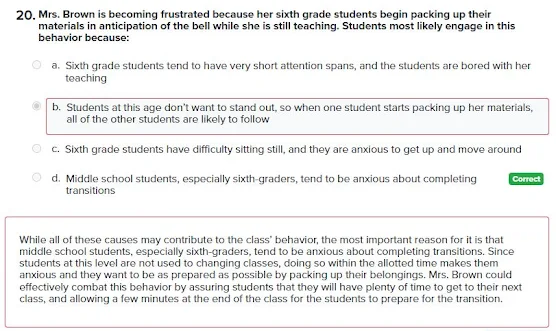Professional Teaching Knowledge Exams
Teacher Leadership
Objectives:
In this workshop you will gain an understanding of:
- Building networks of support
- Advocacy
- Leading professional development
- Reflecting on practice
- Cultural competence
- Action research
- Teacher Leadership
Leadership skills are an essential part of teaching practice. Teachers must manage classrooms, develop long-range plans for their curriculum, and manage a budget and set of resources to accomplish that goal. Teachers can also fulfill leadership roles in their schools. Teachers who engage in leadership activities are engaging in professional development for themselves which also impacts the professional growth and experiences of others in the school community. Teachers have opportunities to be grade-level and department chairs, instructional coaches, instructional trainers, PLC leaders, participate in building leadership teams, and hiring boards, serve on the school council, and lead committees.
Teachers who serve as leaders have the opportunity to discuss and address teacher concerns with other building leaders which has a big impact on the culture and climate of the school. Teachers can be leaders in many different areas and through many different activities. They share a common purpose in that they all act to improve the school community. Even schools with excellent climate and achievement scores rely on teacher leaders to maintain high standards and find opportunities for improvement.
Some core competencies for teacher leaders include:
- Engages in reflective practice
- Serves as a model for others
- Self-awareness
Engages in the activities and issues of the school community
- Communication
- Leverages technology
- Reflective Practice
A well-developed teacher will have a good knowledge of several different effective strategies to use in the classroom. Having a toolbox full of strategies is great, but teachers also need to be able to select the right tool for the job. While many strategies can be effective in a situation, it is often the master teacher who is most successful in choosing the right strategy for a particular lesson for their students. Novice teachers can build skills in selecting the right tool for the job by engaging in reflective practice.
Reflective practice is the process through which a teacher considers and challenges their own practices with the intent to improve. When engaging in reflection, teachers should pay particular attention to issues of equity and bias, intention and action. Intentional reflection on teaching practice adds context to a teacher’s existing knowledge and helps develop a higher level of understanding.
In order to be effective in reflecting on practice, a teacher must be willing to view themselves as a professional that is willing to take risks, that is willing to be flexible, and that is willing and capable of growth. Reflective practice requires teachers to question themselves and to be willing to find room for improvement.
- Sample questions for reflective practice:
- Did this lesson accomplish what I intended?
- Why did a particular student respond that way?
- Was there an opportunity to make this lesson more culturally relevant?
- Why did I respond that way?
- What assumptions did I make about my students when planning this lesson and how did these beliefs
- influence my instruction?
- Did I make this lesson more difficult on myself than it should have been?
BuildingNetworks
Connecting with the larger school community can be critical for teachers to be highly effective. In order for students to be successful they must have support from the family and oftentimes they require support from the community as well. Engaging the community as collaborators in improving the educational outcomes of your students provides additional support for the students and teachers and provides a real-life context for much of the classroom work. When students are able to see that they are important to the community, their success will more easily follow.
Building a network of support may seem overwhelming, but people in your community want to be involved, and they want to help.
Get the word out. Public awareness can be crucial in generating support in your community.
Community
publications, local newspapers, and the school’s social media are great ways to let the community know about the efforts in your classroom. Schools usually have several social media outlets and will be able to reach a far wider group than your classroom social media account.
Identify a core group. You probably have already identified a couple of parents or colleagues who have been friendly and offered to help somehow. Identify three or four core people and engage them in conversation about the goals for your students.
Form a purpose. Be specific with your core group about their objectives. It is helpful to develop objectives together. When people have a clear understanding of their mission and vision they are more easily able to identify the things that they have to offer and can bring to the table. If they have participated in developing the mission, vision, or goals, they will have a strong investment in success. Specific goals such as “all the students will participate in our field trip” or “all students will have mentors for the science fair” are reasonable and challenging objectives that will motivate people to meet specific targets. If the goal of your group is too general, such as “create a better educational experience” participants won’t have sufficient direction and will either do nothing or pursue things separately.
Engage the group in the continuous improvement cycle. Apply the cycle to your group’s purpose and keep members involved. If your group’s purpose is that all students will have mentors to the science fair, share monitoring, host sneak previews, and celebrate accomplishments along the way.
PTK - Q/A 80
Q.1. Which question below is MOST likely to generate the widest range of answers and discussions among students?
a) Why would the author have ended the book this way?
b) Which of these three books is your favorite?
c) What is the main character's worst flaw?
d) How did the narrator help the story?
Answer Explanation :
This question allows for both a wide range of answers and a discussion of those answers.
The discussion is likely to be interesting because there are so many possible answers to the question.
The remaining answer choices have a limited range of answers.
Discussion may peter out more quickly because many students may share the same answer and reasoning.
“Why” questions tend to be the most open-ended.
Q.2. Why should a teacher always spend time explaining classroom rules during the first few days of class?
a) To allow more relaxed and friendly conditions to evolve later.
b) To establish authority.
c) To give students a chance to participate in making the rules.
d) To establish clear expectations for performance and behavior.
Answer Explanation:
Students benefit from clear, firm guidelines from the outset.
The rules should be changed only when necessary,
not casually or according to student demands, as implied in choices A and C.
Q.3. Which of the methods below will BEST hold students accountable for their full participation in cooperative learning groups?
a) Allow students to evaluate each other on several measures of participation after the activity is completed.
b) Assign each student in the group a specific role in accomplishing the objectives of the activity.
c) Grade students' products from the activity individually and not based on group work.
d) Group students with friends so they are highly motivated to work together.
Answer Explanation :
If each student has a role in meeting the objectives and the activity is well structured,
then all students will be drawn into participating because they all have something to do. Grading students’ Working individually can be appropriate during cooperative learning activities, but if the group process is not also evaluated, then some students will decline to participate with their group. Evaluating each other can become awkward and unfair for numerous reasons, so it should be generally avoided.
Q.4. When teachers share standardized test results with parents, there is a large amount of information in the score report to be discussed.
Which information will be of MOST use to the typical parent?
a) How the student compares to other students in the nation
b) The student's approximate reading grade level
c) Specific areas of academic strength and weakness
d) Average scores in their child's school and grade
Answer Explanation :
Parents will generally benefit most from specific information about how to help their child succeed. When parents know their child’s weaknesses, they can emphasize working to improve them. Parents may want to know how their child has done in comparison to other students, locally and nationally, but the information does not help their child improve.
Q.5. Suppose your objective for a lesson is “The student will demonstrate an ability to differentiate among igneous, sedimentary, and metamorphic rocks.”
Which of the following is the BEST activity for introducing students to the attributes of each type of rock?
a) Students examine rocks belonging to each group and identify the similarities and differences.
The activity is followed by a group discussion in which the teacher brings out the important characteristics of each type.
b) The teacher writes a list of different types of rocks on the chalkboard and talks about the differences.
c) Students take a field trip to a local park and find examples of each type of rock.
This activity is followed by having the students make bulletin boards about igneous, sedimentary, and metamorphic rocks.
d) Students go to the library and look up the various kinds of rocks, making a chart of the important characteristics of each type.
This activity is followed by a film that reinforces the concepts.
Answer Explanation :
Students learn best when they are actively involved. Choice B is too passive; the teacher will be more involved than the students.
Choice C is better for a follow-up or assessment activity after an introduction.
Choice D is missing an important piece of the lesson—actual rocks.
Q.6. A group of students wants to produce an electronic magazine that publishes original student writing and art. Their adviser is planning a unit to train them how to use a word-processing application to create pages that include features such as images, multi-column layouts, sidebars, headers, footers, links, and page backgrounds.
Which of the following would be the BEST culminating activity for this portion of the training?
a) A mastery test that includes essay and multiple-choice questions and has a high standard for a passing score
b) Each student producing a document under proctored conditions, using a set of specific features, and without reference materials
c) Small teams producing a document under proctored conditions, using specified features, and within a time limit
d) Each student working under proctored conditions to produce a document with six different features they select
Answer Explanation:
The purpose of the training is to prepare students to apply what they learn.
The team and time limit conditions make the performance more realistic; the whole activity promotes retaining and transferring what has been learned.
Written tests are not ideal for gauging student mastery of a process.
Since students will be working in groups to produce the magazine, testing their solo performance is also unhelpful.
Q.7. Which of the following is MOST likely to promote effective transfer of knowledge to students?
a) Covering a large number of related topics quickly.
b) Having students work on their own with specific information related to a topic before giving an organized lecture.
c) Having an open discussion on a topic before any specific information related to the topic is given.
d) Covering organizational principles of a topic and then giving students information about specific subtopics.
Answer Explanation:
Studies indicate that topics need to be organized and connected in order to promote the transfer
of knowledge, but that a large number of topics covered quickly will hinder student transfer because students have too little time to connect and organize the information. Introducing organizational structure early makes student learning difficult in that they first need specific information about the topic before the organizational structure can make sense and be remembered.
Choice C is not likely to be instructive, as students need to have some knowledge about a topic before participating productively in a discussion.
Q.8. Students are about to take a paper and pencil test. If there is time for only one of the following activities, which would BEST prepare the students for the test?
a) Students should go over their notes and homework assignments.
b) Students should make a chart of the important topics with notes on subtopics below each.
c) Students should play a teacher-developed game as a class, answering test-type questions.
d) Students should work individually on test-type questions.
Answer Explanation:
Organizational structures help students to connect and remember. Choice A leaves students to their own devices to develop structure, which would work only with the most advanced students. Choices C and D, although they could be helpful, would not give as much support as an organizational structure.
Q.9. Which of the following learning objectives uses a higher-order thinking skill?
a) The student will name the capitals of all 50 states.
b) The student will classify given astral bodies (given their important attributes) as comets or meteors.
c) The student will solve a quadratic equation.
d) The student will create a metaphor to describe an emotion.
Answer Explanation :
Bloom’s Taxonomy identifies thinking skills in increasing order of sophistication as
knowledge, comprehension, application, analysis, synthesis, and evaluation.
Answer D requires synthesis in order to complete the task.
Q.10. Which of the following would provide the BEST introduction for a lesson on writing bibliographic references?
a) Tell students to find a book with bibliographic references and copy the format.
b) Demonstrate to students the specific procedure and order expected.
c) Have students read bibliographies at the end of various texts and identify the elements of the citations.
d) Instruct students to list the important information given on the first two pages of the book.
Answer Explanation:
Writing bibliographic references is a procedure, and procedures are best taught through demonstration. There are a variety of formats for citations, but students need to be consistent in their format, so the teacher needs to specify the important elements.
Q.11. Which of the following phrases BEST completes the following sentence? “Vocabulary should be taught…
a) in every subject area in order for students to master the subject matter."
b) by giving students vocabulary lists to memorize every week."
c) as a separate subject area."
d) by the English department faculty because they are experts in teaching words."
Answer Explanation:
The English department cannot possibly teach all of the vocabulary
intrinsic to a particular subject. Rather than expecting students to memorize vocabulary,
it is more effective to help “hook” the words to vocabulary words students already know and
to use those words in context both in class and in homework.
Choice C implies that more focused attention would lead to better student vocabularies,
but vocabulary study without context is rarely retained.
Q.12. A social studies teacher wants students to consider the role of geography in population patterns.
She asks her class, “What role did geography play in the growth of Chicago as a major U.S. city?” What should she do next?
a) Allow students to call out answers and write them on the board.
b) Tell students not to call out responses but to raise their hand when they think of an answer and wait to be called on.
c) Call on a student and ask for an immediate response.
d) List some possible answers on the blackboard and ask students which they think are best.
Answer Explanation:
Students need various amounts of time to think through an answer to a question,
particularly for complicated questions. Allowing students to answer right away can stop the thinking process for the other students. Calling on a student allows the rest of the class to stop thinking about the problem, too, and puts the student in an embarrassing position. Choice D may be an option if the discussion gets stalled, but students should be given plenty of time to come up with their own ideas before the teacher starts prompting them.
Q.13. Consider the following two questions a teacher might ask a high school social studies class.
I: According to our textbook, what does the public welfare system do to solve the problems of poverty?
II: What are some ways our country might solve the problems of poverty?
Which of the following best describes the differences between these questions?
a) I invites more critical thinking than II.
b) II invites more divergent thinking than I.
c) II is closed-ended and I is open-ended.
d) I invites more divergent thinking than II.
Answer Explanation:
This question is a matter of relative convergence and divergence.
Question I converges on the textbook; that is, good answers will stick to what the textbook says.
Question II allows for answers that may draw on sources other than the textbook. Both questions are open-ended.
Q.13. How should a teacher generally begin almost every class?
a) By engaging in some casual conversation with students.
b) By reminding students to pay attention.
c) By telling students what they will be covering that day.
d) By reviewing skills learned during the previous class session.
Answer Explanation:
Telling students what they will be covering helps focus students’ attention.
A teacher should remind students to pay attention if she notices that their attention is wandering,
but she need not start every class with this reminder. Reviewing skills is helpful on occasion, but not in every class.
A casual conversation with students builds rapport but should be reserved for before or after class.
Q.14. What activity would BEST help students in a middle school social studies class understand why different Native American tribes had different trading practices?
a) Give a carefully constructed lecture that covers the similarities and differences among tribal trading practices, while having students take notes on the outline of the lecture. Follow up with worksheet questions to answer.
b) Assign a tribe to each group of students and give each group handouts that identify needs and oversupply for a particular tribe. Then stage trading activities among groups and have students identify important aspects.
c) Have students compare and contrast the trading practices of Native Americans with the trading practices of pioneer settlers, developing a list of differences and similarities.
d) Show students pictures of Native Americans trading articles and explain the differences between the different types. Give specific reasons why different tribes traded certain articles.
Answer Explanation:
Students engaged in active participation are more likely to learn and understand complex interconnections. Choices A and D are generally passive for students. Choice C is off-topic.
Q.14. A struggling student comes to pick up a paper at your desk during class time. You have determined that this student needs extra help.
Which of the following would be BEST to say to the student?
a) "Come in at lunch and I'll help you work on the problems in this paper."
b) "This paper needs work. Would you like my help?"
c) "I had another student like you who needed help with this topic. When can you get help?"
d) "I'd like to talk to you about this paper in a little more detail. Let's set up a time when we can talk in private."
Answer Explanation:
It is important to protect student privacy and avoid embarrassment.
The vital issue is not to share the lack of success with the rest of the students.
Q.15. Consider the following question asked by a first-grade teacher:
“What do the three stories we have read by Tomie de Paola have in common?”
What is the main instructional value of asking a question like this?
a) Factual recall of characters from the three stories
b) Analysis of the separate stories and comparison between them
c) Analysis of the themes the author carries across the stories
d) Factual recall of specific events from the three stories
Answer Explanation:
This question utilizes comparisons, which is part of the fourth level of Bloom’s Taxonomy, analysis. The teacher is looking to see which students are able to think of all three stories at the same time and make comparisons between them. Choice C also covers analysis, but it limits the analysis to a single subject and themes. The teacher is not looking specifically for factual recall in this higher-order thinking question, although recall may also occur.
Q.16. If a school wanted to compare how its students were doing with respect to students in other schools, what kind of assessment would be MOST appropriate?
a) Norm-referenced test
b) Criterion-referenced test
c) Performance assessment
d) Portfolio
Answer Explanation:
A norm-referenced test is designed to give a percentile score that places each student on a continuum of 1 to 99+.
The other assessments are difficult to use to compare large groups of students.
Q.16. A teacher is planning a lesson for a unit on the portion of the Seven Years' War fought in North America between England and France, known to Americans as the French and Indian War.
The lesson's main goal is to show the relative strengths and weaknesses of English and French forces in North America. Which of the following aids would be MOST useful for reaching that goal?
a) Maps showing which parts of North America each nation controlled at the start of the war
b) A comparison/contrast chart for students to fill in as they work through the unit
c) A timeline showing major events before, during, and after the fighting
d) Projected or online facsimiles of original documents, letters, and diaries
Answer Explanation:
A chart of this type helps students focus on similarities and differences as they study.
Maps, timelines, and facsimiles of primary materials are all standard materials for teaching history, but they do not directly support the comparison and contract processes.
Q.17. Suppose you want students to learn to distinguish between the words imply and infer.
Which of the following sequences would be MOST effective?
a) Have students apply the terms to their own examples and then explain the distinction.
b) Be sure students can work without your direction, then ensure the skill is retained.
c) Explain the distinction, then have students evaluate their own examples.
d) Explain the distinction, then have students apply the terms to their own examples.
Answer Explanation:
The first three choices are all out of sequence in one way or another.
For instance, B is incorrect because students cannot work independently until a skill is retained.
Q.18. In order to use an inductive sequence for teaching about World War II,
which of the following would be the BEST way for a class to work?
a) Arrange events, persons, and groups along a timeline leading up to and through the war.
b) Examine events leading up to the war and develop a general model of world war in the process.
c) Learn a model of world warfare and examine how World War II fits into the model.
d) Examine how different persons, groups, and events contributed to the war.
Answer Explanation:
Induction is the process of building a general model. Choice C is deduction. Choices A and D are interesting and potentially valuable—either might fit into a general model—but neither one is inductive or deductive.
Q.19. Which of the following statements BEST illustrates a proven technique for encouraging student effort?
a) "I know you can do it if you really try."
b) "You do this better than any student I've ever had."
c) "You're exactly right here and here. Now check this."
d) "You look great today. How's it going?"
Answer Explanation:
Choice C gives a student-specific feedback about successful learning or performance and also points ahead to even better performance.
Choice A tries to be encouraging, but it’s not specific and hints at a lack of effort. Choice B sounds exaggerated.
Choice D does not encourage effort directly.
Q.20. A student, usually well-behaved, is being disruptive at the moment.
Which of the following techniques is an effective first intervention?
a) Ask, "What's up with you today?"
b) Say, "Watch what you're doing."
c) Move closer to the student.
d) Tell the student to stay after class.
Answer Explanation:
Moving closer is a good nonverbal cue that the teacher has recognized something that needs attention, yet it gives the student a chance to correct things on the spot.
Q.21. Given the following set of scores on a standardized test,
which choice most closely approximates the difference between the mean and median of the set- 89, 65, 77, 93, 80, 87, 79
a) 1
b) 3
c) 28
d) 80
Answer Explanation:
The mean of the data is 81.43 and the median is 80. The difference between them is 1.43, which is closer to 1. Choice C is the range of scores and D is the median.
Q.22. A fifth-grade student has just finished a three-week unit on the American Revolution in social studies.
Which strategy would be BEST to use to culminate the unit?
a) Give a free-response test on the "big ideas" of the unit and have students choose a project from a list of eight projects.
b) Have students design a project that shows what they have learned about the American Revolution.
c) Give a multiple-choice test that emphasizes remembering people, places, and dates of the American Revolution.
d) Read a short story that is set during the American Revolution to tie the social studies and language arts curricula together.
Answer Explanation:
In order to know whether the learning objectives of the unit have been met, the objectives must be measured.
A test on the major concepts of the American Revolution achieves that goal. The project,
from a limited number of choices that relate to the objectives, gives students another way to show what they have learned.
Choice B is too free-form, and students may not show that they have met the learning objectives for the unit.
Choice D is an excellent way to tie the subjects together, but it is not a culminating activity that shows what students have learned.
Q.23. A student comes to you and says, “I just can't do math. My dad can't either. I don't have that kind of brain.
I just don't get it.” Which of the following is the BEST response to this situation?
a) Ease up on the student, and provide successful experiences to enhance what that student does know.
b) Offer additional help and explain that you will pinpoint the areas that are causing problems and work through them.
c) Tell the student you will meet with his parents to discuss the situation.
d) Point out that everyone has strengths and weaknesses.
Answer Explanation:
All students should be accountable. It insults students when the teacher assumes they cannot learn and gives them an excuse to avoid a challenge.
Q.24. Which of the following language arts activities requires the highest order of thinking skills?
a) Summarizing a chapter from a novel.
b) Comparing and contrasting two main characters from a novel.
c) Imagining and writing a new ending to a novel.
d) Identifying the major and minor characters in a novel.
Answer Explanation:
Imagining and writing a new ending to a story is an example of the synthesis level of thinking on Bloom’s Taxonomy.
The six levels of thinking skills that Bloom identifies are
(1) knowledge, as in choice D; (2) comprehension, as in choice A;
(3) application; (4) analysis, as in choice B; (5) synthesis; and (6) evaluation.
Q.25. Two students work together to prepare visual aids that illustrate the major waves of immigration to the United States.
The activity satisfies which of the following learning objectives?
a) Analyzing cause and effect.
b) Communicating in suitable ways.
c) Providing adequate support for claims.
d) Making inferences.
Answer Explanation:
Preparing visual aids necessarily engages students in thinking about what’s suitable for the content, purpose, and audience.
Their content may or may not require analyzing for cause and effect, for making claims or for making inferences.
Q.26. Curriculum planning is a major aspect of a teacher's job.
Which teaching practice listed below will BEST help students to achieve grade-level outcomes?
a) Consulting the state curriculum on a frequent basis.
b) Planning units of study that are interesting and then consulting the state curriculum to be sure that the standards are incorporated into the lessons.
c) Using the state curriculum at the beginning of the school year to determine the learning objectives for the year, which are then incorporated into units of study.
d) Using the textbooks and materials mandated by the school district because they have been chosen to meet the standards for each grade level.
Answer Explanation:
A teacher should have a plan for the school year before the year begins so that he or she is sure to teach the required learning objectives.
The units of study can then be constructed around the objectives, rather than the reverse, which is suggested in choice B.
The textbooks and materials will most likely cover the grade-level objectives and more;
they are rarely designed specifically enough to meet a teacher’s exact needs.
Q.26. A nine-year-old student with diagnosed Attention Deficit Disorder (ADD) is in a regular education classroom.
He has average ability in math.
Which strategy below will MOST effectively help him memorize his multiplication facts?
a) Provide the student with a multiplication table to help him complete the classwork.
b) Have him spend 15 minutes per day using a computer program that practices multiplication facts.
c) Partner him with another student who also needs to practice multiplication facts.
d) Have him complete a multiplication fact worksheet at the beginning of math time until he learns the facts.
Answer Explanation:
A multiplication fact program on the computer will probably hold his interest for more time than any of the other strategies, which means he will practice more.
Working with another student may be a chance to goof off, rather than focus on practicing.
Q.27. When planning how students will practice correct spelling of the words “there,” “their,” and “they're,” which of the following is the BEST pattern?
a) Practice frequently at first, spread out practice after that.
b) Begin with few repetitions and then build up the speed and number of examples.
c) Use a flexible schedule during at least the first five days.
d) Practice the same number of times and increase speed.
Answer Explanation:
Frequent initial practice helps people to acquire a skill and develop frequency with it. Further practice aids retention.
Choices B and D risk not getting the skill established and having students practice mistakes later on.
Q.28. A teaching unit should be designed so that key skills are
a) mastered well before the midpoint of the unit.
b) presented in substantial chunks and practiced before proceeding.
c) practiced early and in substantial chunks.
d) practiced frequently until students retain them.
Answer Explanation:
Frequent practice distributed across the available time period helps students develop fluency.
In most cases, smaller chunks work better than big ones.
Q.29. A teacher is planning how to explain classroom assessment practices to a group of parents.
Which of the following could be used as an example of formative assessment?
a) Comparing student performance on a posttest compared to a pretest.
b) Analyzing standardized test scores to show how students in one school compare to those in other schools.
c) Evaluating whether teaching practices need to be changed based on student self-evaluation.
d) Using a diagnostic test to predict whether students will do well on a standardized test.
Answer Explanation:
Formative assessments are those that give indications of what needs to be adjusted, corrected, or otherwise improved based on feedback.
They guide instruction that is taking place. Choices A and B are examples of another category of assessments: summative.
They sum up instructions that have been completed.
Q.30. A student is returning to school after being hospitalized for three months.
Which accommodations should a teacher consider?
a) Relaxing behavior standards.
b) Giving additional time to complete assigned work.
c) Assigning another student to assist the returning student with classroom work.
d) Lowering performance accuracy standards temporarily.
Answer Explanation:
Time to complete work is typically the most important accommodation needed after a long absence. Most students who have been absent realize they will have adjustments to make and their classmates realize this as well. Lowering expectations for in-class behavior or performance does not help the student progress.
Assigning another student to help only slows the student’s recovery, and is unnecessary if extra time is granted for completion of assignments.
Q.31. Of the following verbs or verb phrases, which one is most fitting for an objective concerned with students' ability to generalize?
a) List and describe what you remember...
b) Define and explain each of the following...
c) Find and explain additional cases of...
d) Evaluate how well...
Answer Explanation:
Generalizing is the process of extending what has been learned. In its most precise sense,
it calls for finding identical cases or uses of what has been learned. At the very least, it calls for finding very similar cases or uses. Choices A and B do not call for generalization.
Instead, they operate with what students can recall or are given.
Choice D clearly calls for an evaluation of some kind.
Q.32. A teacher thinks a student is under a great deal of stress, perhaps because of a bad relationship with a parent and step-parent.
Among the following choices, which is the first thing that the teacher should do?
a) Arrange a conference with the parent and step-parent.
b) Refer the student to a professional help provider.
c) Adapt assignments to draw the student out.
d) Watch for signs of destructive behavior emerging.
Answer Explanation:
In such a case, the first order of business is getting the best available help for the student.
The teacher may be valuable during or after another professional is engaged.
A conference with the parent and step-parent is premature.
As for Answer C, it is better for a teacher to stick to educational rather than therapeutic goals.
Another professional might advise the teacher on what behaviors to look for as time goes along.
Q.33. Which activity below would give second-grade students the best practice of discriminating between mammals and non-mammals?
a) Bring cut-out pictures of mammals and non-mammals to class, and have students sort them into "mammal" and "non-mammal" piles one at a time.
b) Compare mammals (such as dolphins) found in the ocean with fish (non-mammals) found in the ocean.
c) Investigate one mammal and one non-mammal more extensively for a class book.
d) Watch a video about the animals, mammal and non-mammal, that live in their state or region.
Answer Explanation:
Since the objective is for the students to practice discriminating between mammals and non-mammals, they need to look at many animals and decide in which they category they belong. Choice A is the only activity that provides exposure to a large number of “practice problems.” Choice C may be a useful activity for the students to learn more about mammals and non-mammals, but it does not offer as much practice opportunity as A.
Choice B does allow for some comparison, but it limits the environment and the animals to be compared, thereby hindering its overall effectiveness.
Q.34. Which of the following statements will require students to analyze what they are working on?
a) "How many of the following ..."
b) "What are the main features of ..."
c) "What would you suggest for ..."
d) "Retell in your own way..."
Answer Explanation:
Choice B requires students to divide something into its constituents, the heart of analysis. Choice A calls for basic knowledge.
Choice C invites a kind of evaluation plus generating options. Choice D requires comprehension.
Q.36. When students cannot transfer a concept from the classroom to other settings the most common reason is
a) irrelevance of the concept to their lives.
b) inattention during key lessons.
c) hostile attitudes toward school.
d) insufficient practice with transferring it.
Answer Explanation:
According to researchers, most people do not transfer what they learn unless they are encouraged or required to do so.
Q.37. What would be the MOST expedient way for a teacher to find out whether students know specific facts about whales?
a) In small groups, students make webs showing what they know about whales.
b) Students take a multiple-choice pretest about whales.
c) The teacher takes notes during a class brainstorm about whales.
d) Students write an in-class essay about whales.
Answer Explanation:
If a teacher needs to know whether students know certain facts, a multiple-choice is a fast way to find out. Making webs in small groups would allow students the time to share everything they know about whales and build on each others’ knowledge, and may give the teacher an idea of what they know, but it will not give her all the answers she needs quickly. The class brainstorm would generate similar information as the webs made by the small groups, but fewer students would participate and their participation would be limited to a few comments, making this even less effective for the teacher.
Q.38. The faculty adviser to a student website is training students to use photo processing software.
What should the adviser plan to do after students have successfully tried the basic skills of importing an image file and saving it in an appropriate format for use on the web?
a) Have students practice the skills until they meet a predetermined standard of quickness and accuracy.
b) Learn how to upload the images to the web server without losing quality.
c) Find out how much students already know about website development and transferring photos to websites.
d) Explain how to do basic photo manipulations in the software program.
Answer Explanation:
The students have acquired a skill, and the next step should be to build fluency.
Fluency is a combination of speed and accuracy. Choices B and D have to do with introducing new skills that can be acquired after the first is mastered.
Choice C is incorrect because the adviser should find out what the student's current skills are before beginning training, not after
Q.39. The teacher has written the following objective for her fifth-grade students:
“The students will correctly locate 45 of the 50 United States on a blank map of the United States.”
Which of the following is the BEST way to assess whether students have met the objective?
a) The students take a test where they match the individual shape of a state to its name.
b) The students take a test where they are given a blank map and a list of all 50 states.
The students write in the name of each state in its correct location on the map.
c) A map of the United States is grouped into 5 regions, and each region is studied and tested separately. The test consists of writing the name of each state from memory onto a blank map of the region.
d) The students work in pairs to fill in a blank map. Each pair has a list of all 50 states and an atlas to reference.
Answer Explanation:
The students are not asked to memorize the names of all 50 states, only to locate the states on a blank map, so a list of the states is appropriate for them to work from as they fill in the map. They should not use an atlas during the assessment of the objective. Grouping the states into regions (choice C) may be a useful way to teach the location of the 50 states and to check the students’ understanding as the unit progresses, but it does not assess whether they know 45 of the 50 states on a blank map.
Q.40. A ninth-grade teacher plans to teach his students how to use latitude and longitude to locate places on a map.
He wants to build upon students' prior knowledge, so which of the following would be MOST logical to link with lessons on latitude and longitude?
a) Using a local map to find places they know.
b) Graphing ordered pairs on a coordinate plane.
c) Relating finding places to a scavenger hunt.
d) Explaining how early explorers figured out where they were going.
Answer Explanation:
Finding a specific location using its latitude and longitude is the same concept as plotting points using ordered pairs in math. By ninth grade, students have generally mastered this skill, so it is convenient and pertinent prior knowledge.
Choice D would be pertinent but is less likely to be common prior knowledge.
The other two answer choices are not useful for prior knowledge links specifically to latitude and longitude.
Q. 41. What is the BEST method for reinforcing the proper use of the pronoun “me ”?
a) Have students write a paragraph in which students discuss themselves, using the word me at least 10 times.
b) Give students a structured worksheet that has sentences with a blank to be filled in by me or I.
c) Use an oral practice exercise, in which students sit with a partner and each makes up ten sentences that use me properly.
d) Correct students whenever they use me improperly in class.
AnswerExplanation:
To reinforce newly learned material, students are most successful when practicing in a highly structured way. Therefore, the correct answer is B. The sentences can force the students to practice using the pronoun in a variety of sentence situations, which may not happen in any of the other three practice scenarios.
Also, the worksheet only practices the concept learned.
Q.42. Which strategy should a teacher impart to students to help them reduce their test-taking anxiety?
a) Work through easier problems before tackling harder problems.
b) Study a great deal the last three days before the test.
c) Complete the review assignments for the test without any help.
d) Picture getting the test back with a high grade on it.
Answer Explanation:
Students who are anxious can build confidence on tests
by completing easier problems first, and then working on harder problems. Studying and
completing review assignments helps students be prepared, but many anxious students
do not find that preparation alleviates their anxiety.
Positive visualization is not powerful enough to overcome many students’ anxiety.
Q.43. One of your students is habitually late to class. He arrives without his books and seldom has his homework.
In class, he answers without raising his hand and his comments are typically sarcastic. You have already assigned him to detention,
but you are not getting the results you want. Which of the following actions should be taken next?
a) Move his seat right next to your desk where you can constantly correct his negative behavior.
b) Set up a parent conference and include the student. Ask an administrator to sit in. Create a list of changes you expect, addressing especially his verbal misconduct.
c) Tell your administrator that there is a personality conflict with this student. Ask to have his class changed.
d) Tell the student in private that he is responsible for his actions. Consequently, he will fail your class and continue to get detention for disrupting your class.
Answer Explanation:
If you continue to comment on this student’s outbursts, you are actually reinforcing his negative behavior. A parent conference with the student and another administrator will make the student realize that his actions are detrimental.
The consequences should be clearly defined. By having a parent and administrator present, everyone knows what the consequences
will be if the student does not correct his actions.
Choice D seems reasonable. Chances are the student may fail your class, but the best action is to involve the parents and the administrator.
Q.44. A teacher asked his student to find the area of a triangle. The student's response was correct but was given in an unsure and timid manner.
What could the teacher say to encourage the student's understanding of finding the area of triangles?
a) "Excellent. Let's try another problem like this one."
b) "You're right. How did you figure that out?"
c) "Good. You multiply the base times the height and divide by two."
d) Come up and show us what you did.
Answer Explanation:
Since the student was unsure of his answer, it is helpful for the teacher to confirm his answer first, before challenging him to explain how he figured out the answer. Giving his own explanation will help him understand how to find the area of any triangle.
Trying another problem does not help increase understanding if the concept behind the practice is not explained.
Q.45. Which of the following sets of verbs is best suited to the assessment of how well students can evaluate a body of content?
a) Interpret, justify, support
b) Categorize, sort, subdivide
c) Match, define, identify
d) Show, prepare, produce
Answer Explanation:
Choice B calls for analysis; Choice C for basic comprehension; and choice D for synthesis.
Q.46. A teacher is conducting a lesson on the Industrial Revolution and the significant changes in methods of transportation and travel during that time.
After being called on, a student asks why steam engines are not used in cars today. The teacher should
a) take the teachable moment when a student expresses an interest and contrast the steam-powered engine to car engines of today.
b) acknowledge the question as interesting, yet ask the student to wait until later for the class to travel that thread of thinking.
c) ask the student to stay on task.
d) design the student the responsibility to go to the library and report back to the class.
Answer Explanation:
It is important to maintain continuity and not digress from the teaching objective,
yet the student’s question is germane to the big picture of industrial progress so it should be honored as good thinking. Asking the student to go to the library could be misinterpreted by the students as punishment for asking a question.
The entire class or the teacher should be involved in the task rather than assigning an extra task to an interested student.
Q.47. While observing an experienced teacher you notice that every time a student answers a question correctly, the teacher asks the entire class a new question, frequently related to the previous one, but sometimes pushing the students in a different direction. Which of the following is the MOST compelling reason a teacher might do this?
a) There is a lot to cover, and no time to waste.
b) Maintaining momentum is an important key to facilitating group attention.
c) The students need to be pushed.
d) A teacher asks questions to facilitate student thinking.
Answer Explanation:
Pacing and momentum are very important when teaching groups.
The teacher wants to make sure that all students are engaged while also making sure to cover the necessary content.
Q.48. After grading a test, a teacher notices that the scores are significantly below the students' usual scores.
The teacher decided that he did not communicate the material effectively.
Rather than discard the test scores or unfairly penalize the students, the teacher decides to grade on a curve.
Which of the following distributions will BEST describe the data once it has been adjusted?
a) Bernoulli distribution
b) Continuous probability distribution
c) Normal distribution
d) Poisson distribution
Answer Explanation:
Grading on a curve fits the set of test scores along a bell curve, or normal distribution,
in which the majority of students score near the mean—few students score significantly higher or lower than the mean.
Q. 49. How should a teacher reinforce the “Be prepared and ready to work on time” rule in class?
a) Stand outside the classroom with the door open for the students. A few seconds before the second bell rings, rush into class with a backpack and make a big show of being late. Afterward, talk with the students about the rule for being ready on time.
b) Call on the student who is last to his or her desk to stand up and read the class rules aloud. Then ask the student which rule he or she has just broken.
c) Write down the names of the students who are not in their seats on time. Put their names on the board with a note that says? 5-minute recess penalty.?
d) Give the students a journal-writing prompt to write about the importance of being ready to work on time.
Answer Explanation:
By showing the students how disruptive their tardy behavior is, and following the example
with a discussion of why the rule is important, a teacher is most likely to change their behavior.
Journal writing (choice D) may be effective if it is combined with a discussion about the problem, but it must be linked to the behavior that the teacher wants to change.
The other two choices are consequences, not methods of re-teaching the “Be prepared and ready to work on time” rule.
Q.50. Which of the following tasks requires knowledge of a concept?
a) Converting a fraction to a percentage and a percentage to a fraction
b) Constructing a 45-degree angle
c) Calculating the area of squares, triangles, and circles
d) Categorizing numbers as rational numbers, integers, or whole numbers
Answer Explanation:
Students must have an understanding of each set of numbers in order to categorize new numbers.
There is no step-by-step process, or strategy, to determine the set of a number.
The other three answer choices use cognitive strategies to accomplish the task.
Q.51. A science class has just completed a unit of study on ecology, including vegetative regions and biomes.
Which of the following student activities demonstrates the highest level of content mastery?
a) Compare and contrast ecological characteristics of various areas of the world.
b) Discuss the effects of weather patterns on the ecology of other countries.
c) Label biomes on a world map and provide a general definition of the terms used.
d) Visit a nature preserve and identify characteristics related to the local vegetative region.
Answer Explanation:
Intelligently discussing how a concept applies to other scenarios exhibits
mastery of higher-level thinking. Listing similarities and differences, as in choice A,
labeling using new terms and definitions, as in choice C, and identifying examples based on information already learned,
as in choice D, are among the first stages of content mastery.
Q.52. Which scenario demonstrates the BEST teaching strategy when posing higher-order questions?
a) The teacher poses a question, pauses for three to five seconds, and then asks for a student's response.
b) The teacher asks multiple questions and immediately calls on someone who does not volunteer.
c) The teacher first calls on an individual student, asks a question and waits for the student to respond.
d) The teacher poses a question, pauses for students to think, and then provides the answer to the question.
Answer Explanation:
Typically a question is asked, followed by a brief pause to allow students to formulate an answer,
and then a volunteer or nonvolunteer is asked to answer. Asking multiple questions, as in choice B, can be confusing,
leaving the students unsure of the point of questioning. Calling on a student before asking the question,
as in choice C, gives no time for a student to formulate an answer, and it is likely to negatively
impact the student’s participation. Providing the question and the answer, as in choice D,
does nothing to stimulate students to think about the new material.
Student interest cannot be maintained if students know the teacher will provide all of the information required.
Q.53. During an exam, a teacher notices one of her students attempting to look at a classmate's test.
Which tactic is the MOST appropriate response before she considers more serious disciplinary actions?
a) Say to the class, "I think I see someone cheating."
b) Go over to the student and ask if he or she is cheating.
c) State that it is expected that everyone do his or her own work.
d) Stop the exam and compare the answers of the two students.
Answer Explanation :
Making a statement of an expectation is a simple way to handle situations like this.
All of the students are made aware that the teacher is watching to make sure that everyone is on task.
All of the other choices may cause unnecessary anxiety and disruption.
Q.54. Which of the following knowledge units is a rule relationship?
a) Prime numbers are only divisible by themselves and one.
b) The rock cycle is the process by which rocks are broken down and re-formed.
c) Through photosynthesis, plants convert sunlight into energy.
d) Movement around the classroom should be minimized during class time.
Answer Explanation :
Choice A is a rule that all prime numbers must follow
in order to be classified as prime. Choices B and C are concepts.
Choice D is a behavioral rule, not a knowledge rule.
Q.55. Which of the following strategies BEST maximizes students' learning time?
a) Use a quiet signal directly after the bell rings, then take attendance when the students are quiet.
b) Explain to the students how their time for learning is limited, so they need to come in and be quiet immediately.
c) Do not answer student questions at the beginning of class, but instead ask students to come before or after school to ask any questions.
d) Have an assignment on the board for students to complete in the first five minutes of class while answering questions and taking attendance.
Answer Explanation :
To maximize students’ learning time, a teacher should ensure they are engaged in a productive activity.
A short assignment to be done at the beginning of class can be part of the normal classroom routine,
allowing the teacher to take care of necessary tasks while the students are working.
While a quiet classroom may help a teacher move more quickly to the lesson, the students still will be waiting instead of working.
Q.56. A fourth-grade class has been having a great deal of trouble settling down during transitions between activities,
as well as after recess and lunch. The teacher has decided to speak to the class again about what behavior
he expects and offers them a reward for exhibiting acceptable behaviors during transition times.
Which type of incentive is MOST appropriate in this situation?
a) When the whole class behaves appropriately, they earn points toward a group reward that the class has chosen.
b) When individual students behave appropriately, they earn points toward a group reward that the class has chosen.
c) When individual students behave appropriately, they earn points toward a personal reward from a list of choices.
d) When individual students behave appropriately, they earn a small reward immediately.
Answer Explanation :
The more students who behave appropriately, the faster the students will reach their reward goal.
This also encourages modeling of appropriate behavior, so that there is some peer pressure to help earn more points.
It eliminates the punishing aspects of having a few students who cannot or will not behave appropriately,
which is the problem with having the whole class behave appropriately in order to earn points.
Since the behavior problems involve whole-class management, the incentive should be for the whole class, not the individuals.
Q.57. A third-grade student struggles to spell even basic words. Her parents have come to the autumn parent-teacher conference and discussed the student's previous school experiences and their concerns about her lack of progress in spelling.
How should her teacher respond?
a) Inform them that she will consult the Special Education teacher to see if the student's difficulties may warrant testing for learning disabilities.
b) Explain to the parents that many children have spelling difficulties that they outgrow as they become better readers.
c) Suggest that the parents spend more time practicing the spelling of basic words at home with the student.
d) Explain that she will create a plan to help the student memorize the spelling of basic words.
Answer Explanation :
A primary-level teacher should know where spelling difficulties often originate,
and he or she should feel comfortable consulting the Special Education staff about a student whose parents are concerned.
Although the student could outgrow her spelling difficulties, poor spelling is an indicator of other learning disabilities, so it should not be ignored.
Creating an impromptu plan for “fixing” the student’s spelling difficulties may not address underlying problems.
Q.58. A high school English teacher has assigned a novel for students to complete for a six-week unit. The teacher gives students a reading schedule.
Each day the teacher gives students a pop quiz over the assigned chapters. The teacher then discusses the chapters and has students take notes.
What other type of assessment tools can the teacher use to make sure students are keeping up with the reading and learning the content?
a) Have students complete weekly worksheets, give students a test every other week, and assign a composition about one of the learning objectives.
b) Have students write a summary of the assigned chapters before the pop quiz and take a test after reading the novel.
c) Have students write a book report after reading the novel and create a movie poster that covers one of the learning objectives for the novel.
d) Have students take turns leading the discussions for the chapters and give students a test at the end of the reading.
Answer Explanation :
Worksheets that make students show that they are grasping the concepts of the novel will help the teacher know if he or she needs to review, re-teach, or slow the pace. Giving tests that carry more weight will also help motivate students to keep up with the reading.
The writing assignment allows students to show that they can interpret the novel. Choice B does not provide enough feedback for the teacher or the student.
Creating a movie poster is a good closure activity but does not encourage the students to keep up with the reading.
Having students take turns leading the discussion may cause some students to stop reading after they have had their turn leading the discussion.
Q.59. At the start of a new unit a teacher uses a one-page handout containing a 25-item checklist designed
to get information about what students know and do not know about the unit's subject matter. No names appear on the handout.
The teacher sorts the information into categories including
(a) what most students seem to know already,
(b) what most students do not know, and (c) what misconceptions seem widespread. How should the teacher proceed from this point?
a) Discuss the misconceptions and explain how to eliminate them.
b) Start with what students do not know, building toward their previous knowledge.
c) Explain how the misconceptions develop from not knowing.
d) Start with what students know and move from there to new material.
Answer Explanation :
By starting with what students know, a teacher can help students create connections between their prior knowledge and new concepts.
Q.60. Which type of educational test BEST measures students' performance on specific skill objectives as compared to a performance standard of those skills?
a) Multiple-choice
b) Norm-referenced
c) Criterion-referenced
d) Portfolio assessment
Answer Explanation :
Unlike a norm-referenced test, a criterion-referenced test does not compare students against a sample group of students who took the test, only whether they have mastered specific skills.
Choice A is incorrect because a multiple-choice test can be norm-referenced or criterion-referenced.
Q.62. The reports that schools and parents receive when their students take norm-referenced standardized tests include the student's percentile ranking for each skill or subject area tested. A percentile rank is the percent of
a) questions that the student answered correctly in each area of the test.
b) students from the sample group who scored less than or equal to the student.
c) students from the sample group who scored more than the student.
d) questions answered correctly by students in the same school.
Answer Explanation :
A percentile rank compares a given student to the sample group by showing how many people in the sample group scored worse than or equal to the student. Scoring in the 70th percentile means that a student scored higher than 70% of the students in the sample group. The 50th percentile is considered “average” on a norm-referenced test.
The percentile rank is not the same as the percentage of questions answered correctly on the test.
Q.63. A student has struggled with math for as long as he can remember. Now, as an eighth grader, he resents having to do math,
which often shows in his attitude toward the teacher and class. However, he still wants to understand the material and pass the class.
He turns in his homework regularly but does not always do very well on it. What strategy should the teacher employ to help him be more successful in math?
a) Grade the student's papers more generously than those of students who do not struggle.
b) Call on the student more often in class.
c) Compliment the student on his work so that he will be motivated to turn it in.
d) Check in with the student during in-class work time and answer his questions patiently.
Answer Explanation :
Middle school students tend to respond best to a quiet check-in to be sure that they are on track.
At that time or another private time, they can ask questions that they know the teacher will answer respectfully.
Eighth-grade students are old enough to recognize when they are being falsely complimented and graded with
different standards than their peers, so choices A and C are more likely to fail.
Drawing attention to a student’s difficulties by calling on him more often will only increase his resentment.
Ans: 2
Ans: 1
Ans: 1
Ans: 3
Ans: 4
Ans: 4
Ans: 1
Ans: 4
Instructional Design:
* Writing measurable objectives
* Guiding curricular planning
* Organizing content, concepts, and models
* Developing illustrative examples
* Building on students’ prior knowledge
Books:
https://www.amazon.com/Effective-Teaching-Methods-Research-Based-Instruction/dp/0134054873
Effective Instructional Delivery
These standards cover:
1. Communicating effectively
2. Presenting clear and focused instruction
3. Effective questioning techniques
4. Making efficient use of learning time
5. Applications
6. Research Strategies
Books:
Classroom Management and Organization:
1. Establishing efficient classroom routines
2. Setting clear standards for conduct
3. Providing student feedback & reinforcement
4. Setting expectations for student learning
5. Parental involvement
Books:
Our Pre-K standards promote quality learning experiences for children and address the question, “What should children from birth to age five know and be able to do?” They are a set of appropriate, attainable standards that are flexible enough to support children’s individual rates of development, approaches to learning, and cultural context. These domains are a continuum of skills, behaviors, and concepts that children develop throughout this course of their life. Overall, a Pre-K curriculum should seek to respond to the following objectives:
● Inherent nurturing and responsive practices, interactions and environments that foster trust and emotional security
● Communication and language-rich conversations
● Promote critical thinking and problem-solving
● Social, emotional, behavioral, and language development
● Supportive feedback for learning
● Motivating for continued effort
● Supporting all children’s engagement in learning experiences and activities.
This course is a comprehensive look at the 5 Domains that support the growth of the whole child in an early childhood education program. In addition to providing an in-depth look at each of the domains and the subsequent standards, followed by a Practice in Action section that provides research-based, practical “advice” for each of the domains. The five domains that support the growth of the whole child from birth to age five are:
5 Domains that support the growth of the whole childbirth until age 5
I. Physical Development and Fine Motor Skills
II. Social and Emotional Development
III. Approaches toward Learning
IV. Language and Literacy Development
V. Cognitive Development and General Knowledge
DOMAIN I. PHYSICAL DEVELOPMENT &
FINE MOTOR SKILLS
While physical development generally proceeds in a very predictable manner, there are things that can have a major influence on how and when children achieve these physical milestones.
Nutrition is one important factor that can impact a child’s physical growth. As children enter the preschool years, their diets become much more similar to that of adults. Eating a variety of foods is also important to ensure that kids get the nutrients that they need for healthy physical development.
During this phase, children are working on establishing a sense of independence, so giving them the freedom to express food preferences can be important for psychological development. There are three standards under this domain that explore resources that address a child’s early childhood development of perception, gross and fine motor skills, and health, safety and nutrition.
Standard 1: Health and Wellbeing
Teachers are encouraged to create lessons that support health and well-being to the early development of the children. Physical well-being encompasses all aspects of good health, including nutrition, sleep and regular check-ups. Health, early-care, and education experts have identified several physical health attributes that are crucial to ensuring that young children are ready and able to succeed when they enter school.
Research has found that the presence of these attributes is significantly influenced by the socioeconomic status of the family. Children from lower socioeconomic families are less likely to receive routine health care, including immunizations, developmental and other screening, and dental care. Lack of screening and assessment for physical and developmental needs decreases
children’s enrollment in programs that provide supportive services to meet identified needs, often resulting in developmental delays.
The application of the principles of health and well-being is critical to meeting children’s early health needs can help to ensure that each child will enjoy the health and well-being necessary for school readiness and success. The strategies in this brief represent a starting point for giving early educators the tools to make this possible.
Sample Activities:
● Playing Doctor:
Let the children dress up in white shirts or smocks and take turns playing doctor/patient. You could bring out a shoebox filled with different supplies, bandages, popsicle sticks for tongue depressors, an empty ballpoint pen for pretend needles, etc.)
● Visiting Doctor:
You could discuss why it is important to see the doctor regularly. Ask if anyone knows how to use a stethoscope and ask if they know what a heartbeat is. If they put their hands over their heart, they might be able to feel it beating. You could show them how to take a pulse on their wrists and on their neck.
● Health Talk:
You could discuss the difference between baby teeth and permanent teeth. Discuss how it feels to lose a tooth. Other children might be able to tell you about caring for their teeth, you can emphasize the importance of brushing their teeth in the morning and before bed and should be brushed after meals, the importance of flossing.
● How to Sneeze:
The new recommended way to cough or sneeze into the crook of your arm instead of the hand if no Kleenex is available.
● Fishing for Good Foods:
Children can cut pictures from magazines (or precut) from the five basic food groups. Have the children glue these pictures onto a fish shape cut from construction paper. Slip a paper clip onto the front of each fish. Make a fishing pole from a dowel and tie a magnet onto the end of the string. Label five small buckets with the name/picture of each food group. Have the children try to catch a fish and encourage them to decide which group the food belongs to and then put the fish in the correct bucket.
Standard 2:
Relationship to Space
Under this standard, teachers are encouraged to develop activities that allow students to demonstrate an awareness of their body in space and use their senses to explore the environment and process information. Spatial relationships refer to children’s understanding of how objects and people move in relation to each other. In infancy, children use their senses to observe and receive information about objects and people in their environment.
As they grow older, children use trial and error to experiment with movement. They attempt to fit objects into containers. With newfound mobility, children learn about their own body and its relationship to the physical environment around them. They may crawl around obstacles and over people or move objects out of their way, to reach their intended target.
With growing language and cognitive abilities, children understand words that characterize and describe objects in their environment. They know what a large object is versus a small one and can understand simple prepositions. Their improving hand-eye coordination and fine motor skills allow them to use trial and error in solving more complex challenges, such as fitting puzzle pieces in their corresponding slot or successfully dropping shapes into a shape sorter. Children are able to move their bodies into a small space or bend down to retrieve an object that has rolled under the table.
During the preschool phase, children should be able to use words to describe both people and object properties and can recognize where their bodies are in relation to others without physical trial and error.
Sample Activities:
● Simon Says: Say an action that the children must copy. If your children need a visual cue, complete the movement yourself as you describe it. You can include parts of the body,
gross motor movements, sounds, etc.
● Explicitly teach spatial relationships: Ask children to stand in front of a chair, behind a chair, next to a chair, on top of the chair, and crouch under the chair.
● Dance or move to action songs: Learn action songs and perform the actions as you sing them.
● Work on balance: Encourage your children to balance on one leg, and then the other for as long as possible. Use balance beams or “walk the line” with a piece of painter’s tape on the floor.
● Imitate animal movements: Ask children to imitate the movement of different animals.
Standard 3: Motor Skills
Under this standard, teachers are encouraged to create activities that support fine motor skills in ways that strengthen fingers, work on hand-eye coordination, and helps with their precision.
Motor development focuses on small (turning pages, holding a crayon, building with Legos, cutting with scissors) and large (crawling, running, bouncing a ball) movement skills.
Sample Activities:
Gross Motor Skills:
For preschoolers, active play that uses large muscles in their legs, arms, and upper body is important for good health and physical development. Learning to harness the power of those muscles to run, jump, throw, catch, and kick is key to the healthy growth of bodies and brain.
● Tag or other classic games such as Follow the Leader, Mother May I: Avoid or modify games that force kids to sit still or to be eliminated from play, such as Duck Duck Goose or Musical Chairs.
● Hit the target:
Use hula hoops or chalk to designate targets on the ground, then have kids aim bean bags or balls (even snowballs).
● Paper plate skates:
Use paper plates to glide along on a carpet. Try to imitate speed skaters, hockey players, or figure skaters.
Fine Motor Skills:
Children this age are also working on fine motor skills. These skills are critical for important tasks like holding a pencil, cutting with scissors, using eating utensils, etc.
These are activities that help children strengthen and learn to use small muscles in their fingers and hands.
● Sand play: pouring, scooping, sifting, building
● Puppet shows
● Sidewalk chalk or any art project (finger painting or playing with clay)
● Finger plays: Songs that have accompanying hand movements
● Stringing beads
● Cutting with safety scissors
● Manipulative toys (blocks, puzzles, etc.)
DOMAIN II: SOCIAL & EMOTIONAL DEVELOPMENT
Children’s emotional well-being during their early years has a powerful impact on their social relationships. Children who are emotionally healthy are better able to establish and maintain positive relationships with adults and peers (Trawick-Smith). Consider some of the children in your own life and the different stages in their social-emotional development as they were
growing up.
Preschool-age children are learning to talk about their feelings and the feelings of others. Social-emotional development, however, involves more than just expressing emotions. It entails taking turns, becoming independent in following routines, interacting more with peers, engaging in meaningful relationships with others, controlling emotions, and developing a positive self-image.
These skills are crucial for children’s successful participation in school and home experiences and for their overall growth.
The three standards in Domain II identify ways teachers and caregivers can enhance social interactions among children and adults. As well as discover ways to positively respond to challenging behaviors.
Standard 1:
Sense of Self
Under this standard, teachers are encouraged to allow students to explore a sense of self through self-awareness and self-expression. Even early in infancy, children express their emotions through facial expressions, vocalizations, and body language. The later ability to use words to express emotions gives young children a valuable tool in gaining the assistance or social support of others (Saarni and others 2006). Temperament may play a role in children’s expression of emotion. Tronick (1989, 112) described how the expression of emotion is related to emotion regulation and communication between the mother and infant: “the emotional expressions of the infant and the caretaker function to allow them to mutually regulate their interactions . . . the infant and the adult are participants in an effective communication system.” Both the understanding and expression of emotion are influenced by culture. Cultural factors affect children’s growing understanding of the meaning of emotions, the developing knowledge
of which situations lead to which emotional outcomes, and their learning about which emotions are appropriate to display in which situations (Thompson and Goodvin 2005). Some cultural groups appear to express certain emotions more often than other cultural groups (Tsai, Levenson, and McCoy 2006). In addition, cultural groups vary by which particular emotions or emotional states they value (Tsai, Knutson, and Fung 2006). One study suggests that cultural differences in
exposure to particular emotions through storybooks may contribute to young children’s preferences for particular emotional states (for example, excited or calm) (Tsai and others 2007). Young children’s expression of positive and negative emotions may play a significant role in their development of social relationships.
Standard 2:
Self-Regulation
Emotional and behavioral self-regulation contributes to young children’s growing independence. It is this growing ability to control their own feelings and behavior that eventually allows a child to become more skilled in their relationships with children and adults, for example, when playing together or making decisions together. In the preschool years, children’s self-regulation skills are still developing and can often go up and down. Being able to consistently regulate their own feelings and behavior is a major task for a young child.
By school age, children become more flexible and are better at regulating their own emotions and actions. When children learn to self-regulate, they have stronger friendships and relationships with others, are more able to pay attention and learn new things and deal better with the normal stresses and disappointments of daily life. Parents contribute in many ways to children’s ability to regulate emotions.
Children’s developing capacity to control impulses helps them adapt to social situations and follow rules. As infants grow, they become increasingly able to exercise voluntary control over behavior such as waiting for needs to be met, inhibiting potentially hurtful behavior, and acting according to social expectations, including safety rules.
Standard 3:
Developing a Sense of self with others
Under this standard, teachers allow children to develop relationships and social skills with adults. The child will also develop relationships and social skills with peers. Social-emotional development includes an emerging awareness of self and others. Infants demonstrate this foundation in several ways. For example, they can respond to their names, point to their body parts when asked, or name members of their families. Through an emerging understanding of other people in their social environment, children gain an understanding of their roles within
their families and communities. They also become aware of their own preferences and characteristics and those of others.
Preschoolers develop close relationships with children they know over a period of time, such as other children in the family, childcare setting, or neighborhood. Relationships with peers provide young children with the opportunity to develop strong social connections. Infants often show a preference for playing and being with friends, as compared with peers with whom they do not have a relationship.
Creating Spaces for Emotional and Social Growth
Preschoolers in your care need daily opportunities in a safe and supportive environment to participate in experiences and activities that allow them to explore and celebrate the person they are growing to be. As you meaningfully engage children in this process of self-discovery and identity, you should provide them with ongoing, multiple opportunities to explore their interests, interact with exciting materials, try out new things, and learn. You may already have an “All About Me,” or “My Family” corner in your classroom and you may have weeks in your program designated to exploring diversity, children’s interests, or unique talents. You should embed such opportunities for promoting a healthy sense of self and identity throughout your day and school year in preschool. Listed below are experiences and activities that promote preschool children’s
sense of self.
Embracing Diversity
It may be helpful to reflect on how children learn to see themselves and others in an anti-bias classroom. In an anti-bias classroom, children learn to be proud of themselves and their families, to respect human differences, to recognize bias, and to speak up for what is right. Most educators are thoughtful every day of the subtle ways bias is embedded into systems and experiences. They are mindful of the impact that media messages, choices of classroom materials, and responses to questions have on children’s development of self.
Embracing Character
Our sense of self includes the roles, attributes, behaviors, and associations that we consider most important about ourselves. Character and personality traits are examples of elements that help us develop who we are as individuals; these are cultivated and nurtured through our interactions with others and shape our current and future lives. Use a formal character education curriculum,
Character Counts, which is similar to the Josephson Institute which proposes six pillars that influence the sense of self, positive relationships, and pride in one’s identity and culture:
● Trustworthiness- Be honest, loyal, and keep your promises.
● Respect- Act courteously. Accept others.
● Responsibility-Follow through on your actions and complete your tasks.
● Fairness-Treat people equitably.
● Caring-Show compassion and gratitude.
● Citizenship-Improve the well-being of others.
Embracing Culturally Responsive Experiences
Culturally responsive experiences are those that help children see themselves represented in your classroom. This may mean opportunities for self-reflection and expression. It may also mean broad exposure to people, ideas, and experiences from around the world. Exposure to the world around them sparks curiosity and creative thinking in children. You should provide experiences
that help children define a sense of self and a sense of the world around them. This may include racial or ethnic identity, but it can also include identities related to family values, beliefs, or experiences. One example of creating a culturally responsive experience: explore the culture of living on a military installation, being an only child, transitioning to kindergarten.
The Approaches Towards Learning domain focuses on how children learn. It refers to the skills and behaviors that children use to engage in learning as well as the incorporation of cognitive self-management, independence, curiosity, and creativity.
Standard 1: Initiative and Independence
Under this standard, children will demonstrate initiative, self-direction, interest and curiosity. This standard promotes positive approaches to learning that include child-directed activities during the daily routine. By providing multiple activities from which children can choose, early educators offer opportunities for children to explore activities of their interest. This presents an environment in which children’s curiosity and initiative in approaching tasks are stimulated. It
also gives children opportunities to practice how well they can self-direct and organize their time and actions. If the bulk of the activities planned by early educators are more teacher-directed, then children have fewer opportunities to initiate and practice their explorations, self-direction, or problem-solving.
Standard 2: Attentive and Persistence
Under this standard, children will sustain attention to a specific activity and demonstrate persistence. Cultivate persistence by encouraging the child to follow through on a task. Give them the time and space needed to work independently through tasks as simple as stacking building blocks. The ability to think, retrieve, and remember information, and to solve problems is dependent on the development of attention, or the ability to focus on something in the
environment. Attentiveness is closely related to children’s culture and cognitive abilities.
Children build their capacity to attend and focus through interactions with their teacher. Therefore, teachers should interact in ways that are meaningful for each particular child. The way teachers interact with children depends on their cultural context. Children will increase their ability to stay focused through these interactions, and this ability will continue to improve as they get older.
Standard 3: Learning in Play
As children grow, children become more purposeful when engaging with their environment. They start to experiment with new ways of doing things and expand how they interact with objects and people. This demonstrates growth in children’s cognitive development, as they use objects the way they are intended to be used. While this knowledge is not translated into innovative actions, it does set the stage for the development of creativity in the future.
Once children develop symbolic thought, their play becomes increasingly creative and inventive. Children will use objects in new and unexpected ways. They might place a basket on their head or use their feet to move an object. Children begin to imitate adult actions and use objects to represent things they are familiar with. For example, children may pretend to drink milk out of a
cup or pretend to brush their hair with their hands. Children’s developing language abilities also provide new ways to explore creativity. Children use language to pretend play, engage others in playful interaction, and express feelings and inventive ideas. Children will engage in a progression of imaginative play and demonstrate a cooperative and flexible approach to play and
learning.
DOMAIN IV: COMMUNICATION, LANGUAGE, LITERACY
Early literacy plays a key role in enabling the kind of early learning experiences that research shows are linked with academic achievement, reduced grade retention, higher graduation rates, and enhanced productivity in adult life. This section synthesizes the body of professional knowledge about early literacy and offers research-based recommendations. Promote children’s emerging abilities in language and literacy development. Help teachers and caregivers enhance
the communication abilities of infants, toddlers, and preschoolers.
Here is what we know about literacy and language at this level:
● Literacy development starts early in life and is highly correlated with school achievement
● All of the domains of a child’s development-- physical, social-emotional, cognitive,
language and literacy-- are interrelated and interdependent.
● The more limited a child’s experiences with language and literacy, the more likely he or
she will have difficulty learning to read.
● Key early literacy predictors of reading and school success include oral language,
alphabetic coding and print knowledge.
● Increased demands for program accountability are often heavily focused on the assessment of children’s early literacy development.
● Highly capable teachers are required to implement today’s more challenging early literacy curriculum.
● Teacher knowledge, respect, and support for the diversity of children’s families, cultures, and linguistic backgrounds are important in early literacy development.
A growing body of evidence shows that early learning experiences are linked with later school achievement, emotional and social well-being, fewer grade retentions, and reduced incidences of juvenile delinquency and that these outcomes are all factors associated with later adult productivity.
Key predictive skills and abilities include:
● Oral language
● Listening comprehension, oral language vocabulary
● Alphabetic Code
● Alphabet knowledge, phonological/phonemic awareness
● Print Knowledge/Concepts
● Environmental print, concepts about print
Under this domain, the three standards promote children’s emerging abilities in language and literacy development. Overall, these standards help teachers and caregivers enhance the communication abilities of young learners.
Standard 1: Receptive Language
Under this standard, children listen to conversations and demonstrate comprehension, and acquire vocabulary introduced in conversations, activities, stories, and/or books. Early Literacy includes both spoken components and written forms of language.1 Children develop early literacy skills through
their everyday interactions with their caregivers. These include singing, rhyming, and reading books together. Young children explore books by looking, mouthing, and touching them. They “read” books by simply moving books around or turning pages. These early experiences are the beginning of
reading and writing for young children and influence the development of their literacy skills.
New technology provides children with different opportunities to engage with print and language. For children over the age of two, limited use of electronic media, such as touch electronic readers, tablets, or smartphones, can be enriching, as long as there is interaction with adults.
Standard 2: Expressive Language
Under this standard, children will use nonverbal communication for a variety of purposes and use increasingly complex spoken language. Expressive language refers to how children express their needs, wants, and feelings to others through nonverbal and verbal communication. Communication begins at birth and includes reflexive cries, gaze aversion, and body language.1 After four months of age, children transition to using additional sounds as they build the capacity for verbal language. They produce different types of cries and experiment with
sounds such as cooing, laughing, babbling, and even yelling.
Around nine to 12 months, children begin to point in order to communicate purposefully. They use combinations of gestures and vocalizations to indicate interest in objects and people.2 These are all precursors to the words that will emerge between 12 and 15 months.
Standard 3: Early Reading & Writing
Under this standard, children will acquire meaning from a variety of materials read to him/her, develop early phonological awareness, demonstrate increasing knowledge of the alphabet, and demonstrate awareness of print concepts. Oral language provides children with a sense of words and sentences and builds sensitivity to the sound system so that children can acquire phonological awareness and phonics. Through their own speech children demonstrate their
understanding of the meanings of words and written materials. Learning to read and write is an ongoing process from infancy. Contrary to popular belief, reading and writing do not suddenly begin in kindergarten or first grade. From the earliest years, everything that adults do to support children's language and literacy is critical.
DOMAIN V: COGNITIVE DEVELOPMENT & GENERAL KNOWLEDGE
Cognition and general knowledge skills come together to form the building blocks for school readiness: cognitive processes, creativity, mathematics, science and social studies. Cognition is the broad category for what children know, learn and remember. This includes the thinking skills children use to make sense of all the knowledge they acquire. These important skills help children make meanings, patterns and relationships in their learning.
General knowledge has two components: details about the world around us and social concepts. In order for children to build their cognition and general knowledge skills, it is important for them to engage in a wide variety of activities and experiences that promote learning through both open exploration and focused investigation. Parents and caregivers can support children’s critical
thinking skills by encouraging them to “think out loud” with prompting and conversation, to find their own answers and explore the world around them. Children’s early science and math experiences lay the foundation for their future understanding of more complex science concepts.
Through exploration and discovery, young children build their own thinking and processing abilities. It is critical to implement a variety of strategies to support cognitive development. Under this domain, there are five subdomains that are the foundation upon which children will develop later academic skills in math, science and social studies. This includes simple science skills (observing, classifying and predicting), basic problem-solving skills and basic math skills
(numbers, measurement, shapes and patterns).
Subdomain 1: Math
In preschool math, there are three main goals. Children must develop a sense of math around them. Children must interpret and use numbers. Children must also use math concepts to explore their world. During preschool, we must develop children’s ability to:
Use numbers and counting to explore the world
Spatial realization, shapes, patterns, and colors
Use math to communicate the nature of things (measurements)
The following milestones are a guide in assessing the student’s development in the areas of number sense & counting, geometry, and math communication. Activities using everyday objects and situations should be developed to increase children’s skills in these areas:
Number Sense & Counting
The three-year-old can tell his/her age and use objects or fingers to demonstrate.
The four-year-old can identify the order of numbers in a sequence, typically up to 10
The advanced four-year-old may be able to identify numbers in a sequence up to 20.
The five-year-old understands the sequence and value of numbers i.e. the five-year-old is cognizant of the fact that the number seven is more than the number five.
Space & Geometry
Four and five-year-old children understand spatial orientation like up, down, front, back, over, under, above, on, off, behind, inside, left, right, etc…
Four and five-year-old children should recognize and name basic shapes with different sizes and orientations. These include circles, squares, rectangles, and triangles.
Four- and five-year-old children can copy a shape from memory after looking at it for several seconds.
Measurements
By age three, children figure out how to compare two different objects. They might take sticks and put them side by side and tell which sticks are longer or shorter relative to the group.
Four-year-olds are able to compare objects using words like bigger, smaller, heavier, faster, slower, etc…
By age four, the child should be able to look at two or more containers and express which have the capacity to hold more or less.
Subdomain 2: Science
Research on early math and science learning has found that children acquire more mathematics and science knowledge and skills when provided with a balance of open exploration and focused investigation. Offering the open exploration of well-equipped learning centers during free choice
and small group settings gives children a chance to become comfortable and learn with the equipment and materials. Focused investigations ask children to use the equipment and materials in new or specific ways, find new solutions, and solve problems in order to stretch their learning.
Research has also identified the value of an organized learning environment that includes equipment, materials, games, books, and computer programs that specifically promote exploration and investigation of math, science, and other learning areas.
Specifically, under the Mathematics domain, children learn about numbers, precisions and value, and number relationships. They also learn about spatial awareness through geometry and measurement.
Science is about children developing scientific thinking skills while exploring the natural and physical world around them. Children use their curiosity to explore, question, and investigate earth and physical, and life science at an appropriate level.
Subdomain 3: Social Studies
Social studies gives children an understanding of their sense of self-identity and how people relate to each other in a society. Under this domain, children will focus on: Family, People and Community, History and Events. Teachers help children apply the concepts they learn in their classroom to an understanding of their neighborhood. Children learn to observe their surroundings: the homes, banks, firehouse, police station, restaurants, movie theater, church,
synagogue, mosque, senior-citizen center, schools, playground, park. They observe the kinds of stores in the area: groceries, dry cleaners, tailors, barber shops, clothing boutiques, bookstores, toy stores. They learn what each store sells, where the merchandise comes from, who the customers might be, and why each is important.
Subdomain 4: Creative Development
The skills in this domain help to foster learning and development in all other areas. The arts give children opportunities to apply skills and knowledge in unique, individual, and creative expressions. To help develop their creative skills, focus on creating an environment where your child feels comfortable asking questions about the world and the processes that govern it. Asking
open-ended questions also encourages a sense of exploration. Developing the child’s curiosity can inspire them to dive into the subjects that interest them and cultivate background knowledge that will improve their reading comprehension and other essential academic skills.
Characteristics of a Successful Teacher:
1. Maintains Class Control
2. Provides Deliberate Instruction, Direction and Support
3. Exhibits Content Expertise
4. Masters Teaching Techniques
5. Continues to Learn
6. Organizes Resources, Classroom Procedures, and Lesson Plans
7. Maintains Current and Accurate Records
8. Maintains Clear and High Expectations for Students
9. Models Professionalism
10. Uses Creativity and Their Individuality
11. Displays and Promotes Student Work
12. Presents a Positive Attitude
13. Demonstrates Calm and Confidence in a Crisis
14. Remains Loyal
15. Cares About Students
16. Creates a Caring and Welcoming Learning Environment
Sample Writing Prompt:
Q. Your principal is trying to create an environment in which the staff at your school works together more effectively and has asked for your help.
Write a memo to your fellow teachers on this topic. In this memo include why it is important for staff to collaborate, and possible ways this might be accomplished, and the potential challenges of collaboration.
Your response will be evaluated based on how well you communicate your message to the intended audience, not on your personal opinions, position, or point of view. Your response will be evaluated based on how well organized and focused your writing is, how well you develop and elaborate on your ideas, and your grammar and mechanics.
To: Fellow Teachers
From: Mrs. Jahan
Date: September 15, 2024
Subject: Expanding teacher collaboration efforts


